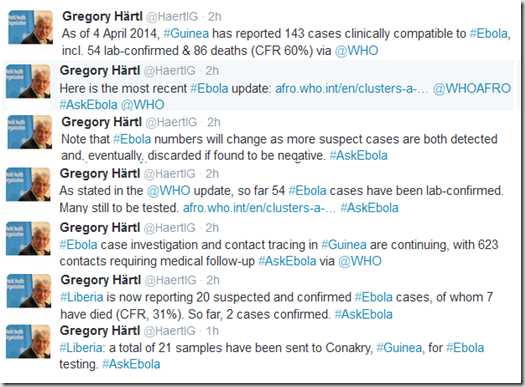Ebola Testing Now Done locally – Twitter picture Promoted by WHO
# 8437
It may be an early Sunday morning, but the World Health Organization (@WHO) and their spokesperson Gregory Hartl (@Haertlg) have been very busy the past few hours providing updates on the latest developments in Africa’s Ebola outbreak via their respective twitter accounts.
With more than 1.2 million followers, the WHO now routinely dispenses breaking news and information first from their twitter account, and then follows up with more detailed postings on their website.
Aside from updating the case counts in Guinea & Liberia, and ongoing activities to combat this outbreak, this morning the WHO reports they have been notified of 4 suspected cases of VHF (Viral Hemorrhagic Fever) from neighboring Mali.
Note - while their symptoms may be consistent with Ebola, they have not yet been confirmed by laboratory testing.
First stop this morning, a link and some excerpts from a detailed update posted yesterday on the Ebola Outbreak, which details the situation in Guinea and Liberia, and then a sampling of some of the messaging coming out of WHO.
Ebola virus disease, West Africa (Situation as of 5 April 2014)
5 April 2014 – As at 4 April 2014, the Ministry of Health of Guinea has reported a cumulative total of 143 clinically compatible cases of Ebola virus disease (EVD), of which 54 are laboratory confirmed by PCR. The total number includes 86 deaths (CFR 60%). New cases have been reported from Conakry, Guekedou and Macenta; 23 patients are currently in isolation units. The date of onset of the most recent laboratory confirmed case is 3 April.
The current number of clinical and confirmed cases and deaths by place of report is Conakry (18 cases, including 5 deaths), Guekedou (85 cases/59 deaths), Macenta (27 cases/14 deaths), Kissidougou (9 cases/5 deaths), and Dabola and Djingaraye combined (4 cases/3 deaths). Sixteen of the 18 clinical cases in Conakry have been laboratory confirmed for EVD. There has been no increase in the number of affected health care workers (HCW) from the 14 reported previously, including 8 deaths; 11 of the affected HCWs are laboratory confirmed cases. Sixteen of the 86 deaths overall are laboratory confirmed, 65 are classified as probable cases and 5 as suspected cases.
Case investigation and contact tracing are continuing, with 623 contacts requiring medical follow-up; this includes 74 new contacts identified on 3 April while 49 have been released from observation as they have remained well after the maximum incubation period for EVD of 21 days following the last exposure to a case. Laboratory support for the investigation is being provided by Institut Pasteur Dakar, Senegal, and the mobile laboratory in Guekedou. Reference laboratory functions have been provided by Institut Pasteur Lyon, France, the Bernhard-Nocht Institute of Tropical Medicine Hamburg, Germany, and the Centre International de Recherche en Infectiologie (CIRI) laboratory in Lyon, France.
WHO, in collaboration with technical partners in the Global Outbreak Alert and Response Network (GOARN) has deployed field laboratory support, and experts in anthropology, epidemiology, logistics, clinical case management and infection prevention and control and outbreak coordination to support the response in Guinea.
The Ministry of Health and Social Welfare (MOHSW) of Liberia has reported 18 suspected and 2 confirmed cases of EBV, including 7 deaths, since 24 March (CFR 31%); 7 patients are currently in an isolation unit while 2 suspected cases have been discharged. Four new clinically compatible cases were reported on 4 April. One of the suspected cases is in a health care worker. Both of the laboratory confirmed cases, sisters from Lofa County, have died. The suspected cases include a hunter treated at a hospital in Tapita, Nimba County, who died shortly after presenting to the health facility and a 3 year old boy with a clinically compatible illness who had travelled from Guinea. The deceased hunter gave no history of contact with known cases in Liberia or Guinea and his exposure is being investigated to exclude transmission from an animal source (bush meat). The laboratory results for both of these suspected cases are pending. The MOHSW has placed 46 contacts under medical observation, including those of the second confirmed case who travelled from Foyah, Lofa Country, to Monrovia, Montserrado Country, and then to Firestone in Margibi County. A total of 21 clinical samples have been sent to Conakry, Guinea, for laboratory testing. Counties of concern for EVD in Liberia include Lofa, Bong, Nimba, Margibi and Montserrado.
The following messages come from the WHO twitter account between approximately 0900hrs and 1100hrs UTC April 6th, 2014.
Similarly, the following messages come from WHO spokesperson Gregory Hartl (who is tweeting in multiple languages), during roughly the same time span. A good deal of his time is spent answering specific questions posed by journalists, or providing reality checks when the media occasionally gets ahead of the story.
Aside from following the WHO twitter accounts or searching for #AskEbola on Twitter – you will find that Crawford Kilian has devoted considerable time and energy on Crofsblog to chronicling this outbreak.
For more background on Ebola, you may also wish to revisit these earlier blogs.
CDC Video: Responding To An Ebola Outbreak
A Brief History Of Ebola



